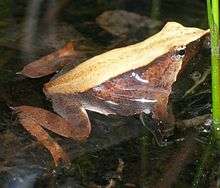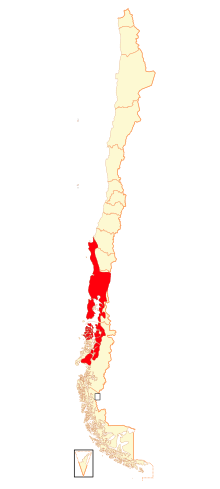Darwin's frog
Darwin's frog (Rhinoderma darwinii), also called the southern Darwin's frog,[2] is a rhinodermatid frog native to the forest streams of Chile and Argentina. It was first described by the French zoologist André Marie Constant Duméril and his assistant Gabriel Bibron in 1841, and is named after Charles Darwin, who had previously discovered it in Chile during his world voyage on HMS Beagle.[3][4][5]
| Darwin's frog | |
|---|---|
 | |
| Scientific classification | |
| Kingdom: | Animalia |
| Phylum: | Chordata |
| Class: | Amphibia |
| Order: | Anura |
| Family: | Rhinodermatidae |
| Genus: | Rhinoderma |
| Species: | R. darwinii |
| Binomial name | |
| Rhinoderma darwinii | |
 | |
| Range in Chile in red (also occurs in adjacent southwestern Argentina) | |
The most striking feature of this frog is the tadpoles' development inside the vocal sac of the male.
Characteristics

Darwin's frog is a small species with a snout–to–vent length of 2.2 to 3.1 cm (0.9 to 1.2 in). The snout is elongated into a fleshy proboscis which gives the head a triangular shape. The limbs are relatively long and slender. The front feet are not webbed, but some of the toes on the back feet usually are.[6]
The upperparts of this species are variably coloured in brown or green. Some brown individuals may have weakly defined V-shaped markings on the back, have central upperparts that are distinctly lighter brown than the flanks, or have whitish front limbs. Females are typically brown and tend to stay on substrates that match this colour. Males are far more variable and occur on a wider range of substrates; especially brooding males often are partially or completely green above.[7] The throat is brownish and the remaining underparts are black with large white blotches in a pattern that is unique to each individual.[5][6]
Biology
.jpg)
Darwin's frog feeds on insects and other arthropods. It not only has to hunt, but also needs to hide from its predators. It relies on camouflage to avoid predators, lying on the ground looking like a dead leaf until the predator passes by. Another defensive position is turning on the back and exposing the boldly patterned ventral surface.[6]
The female Darwin's frog lays up to forty eggs among the leaf litter. The male guards them for about three to four weeks until the developing embryos begin to move, and then he ingests the eggs and holds them in his vocal sac. They hatch about three days later and he continues to carry the tadpoles around in his vocal sac where they feed off their egg yolks and secretions produced by the wall of the sac until metamorphosis. At this stage, about 6 weeks after being swallowed[8] (a duration in which the adult male eats nothing[9]), the small frogs hop out of the male's mouth and disperse.[6]
Distribution and habitat
Darwin's frog is found in Chile and Argentina. In Chile, its range extends from Concepción Province to Palena Province and in Argentina from Neuquén Province and Río Negro Province. It is found in glades and forested areas at altitudes of up to about 1,100 m (3,600 ft) above mean sea level.[1] It is also found in bogs and near slow-moving streams. It is found in a variety of vegetation types and it appears that a mixture of grassland, mossy areas, coarse woody debris, and young trees and bushes in a mature native forest provides its optimum habitat requirements. Short vegetation increases the retention of water while decreasing the temperature of the soil and provides concealment from predators. The population is fragmented and this frog has poor dispersal ability.[2]
Population decline and conservation status
Darwin's frog has undergone significant population declines due to habitat loss and degradation, largely from conversion of native forests to tree plantations. The amphibian disease chytridiomycosis, caused by Batrachochytrium dendrobatidis fungal infection, is also a probable factor, "particularly from the northern part of their historical range". Populations on Chiloé Island were found to be considerably more abundant than on the mainland.[2]
Since 2018, the species is classified as Endangered on the IUCN Red List. A 2013 study reported results of a population survey conducted from 2008–2012, which found the species at just 36 of 223 previously recorded habitat sites, with small populations at those sites.[5] The recent change in its conservation category in IUCN from Vulnerable to Endangered, arose from the Chile's amphibian reevaluation workshop for the Red List (Soto-Azat et al., 2015). The justification for its current category is due to its limited occupation area (estimated at 264 km2), severe fragmentation of its populations and continued decline.
Due to its decline in the wild, captive colonies have been established as a precaution at two zoos in Chile, the National Zoo (working with the US Atlanta Botanical Garden) and Concepción Zoo (working with the University of Concepción and Germany's Leipzig Zoo).[10][11]
See also
References
- Veloso, A.; Charrier, A.; Valenzuela, A.; et al. (2018). "Rhinoderma darwinii". IUCN Red List of Threatened Species. 2018: e.T19513A79809372. doi:10.2305/IUCN.UK.2018-1.RLTS.T19513A79809372.en.
- Soto-Azat, Claudio; Valenzuela-Sánchez, Andrés; Clarke, Barry T.; Busse, Klaus; Ortiz, Juan Carlos; Barrientos, Carlos; Cunningham, Andrew A. (2013). "Is Chytridiomycosis Driving Darwin's Frogs to Extinction?". PLOS One. 8 (11): e79862. doi:10.1371/journal.pone.0079862. ISSN 1932-6203. PMC 3835940. PMID 24278196.
- Bell, Thomas (1843). Charles Darwin (ed.). The Zoology of the Voyage of H.M.S. Beagle, Part V: Reptiles. London: Smith, Elder and Co. p. 48. Retrieved 1 December 2013.
- Duméril, A.M.C.; Bibron, G. (1841). Erpétologie Générale; ou, Histoire Naturelle Complète des Reptiles. 8. Paris: Librairie Encyclopédique de Roret. p. 659. Retrieved 2 December 2013.
- Gratwicke, Brian; Soto-Azat, Claudio; Valenzuela-Sánchez, Andrés; Collen, Ben; Rowcliffe, J. Marcus; Veloso, Alberto; Cunningham, Andrew A. (2013). "The Population Decline and Extinction of Darwin's Frogs". PLOS One. 8 (6): e66957. doi:10.1371/journal.pone.0066957. ISSN 1932-6203. PMC 3680453. PMID 23776705.
- Fran Sandmeier; Kellie Whittaker (8 September 2008). "Rhinoderma darwinii". AmphibiaWeb. Retrieved 6 December 2013.
- Bourke, J.; K. Busse; T.C.M. Bakker (2011). "Sex differences in polymorphic body coloration and dorsal pattern in Darwin's frogs (Rhinoderma darwinii)". Herpetological Journal. 21: 227–234.
- https://animaldiversity.org/accounts/Rhinoderma_darwinii/
- https://web.archive.org/web/20020604085148/http://www.proinco.net/ecobiobio/english/d-bio-2eng.html
- Fenolio, D. (2012). "Conserving South Chile's Imperiled Amphibian Fauna". FrogLog. 100: 30–31.
- "Universidad de Concepción saves Darwin's frog from extinction". thisischile.cl. 26 April 2010. Retrieved 17 January 2020.
Sources
- Crump, M.L. (2003). Grzimek's Animal Life Encyclopedia, 2nd ed., Vol. 6 Amphibians, 175, Gale.
- Duellman, W.E., ed. (1999). Patterns of Distribution of Amphibians: A Global Perspective, 325, The Johns Hopkins University Press.
- Frost, D.R., ed. (1985). Amphibian Species of the World: A Taxonomic and Geographical Reference, 551, Allen Press, Inc. and the Association of Systematics Collections, Lawrence, Kansas.
External links


